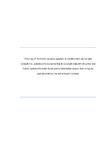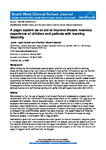Perceptions of Risks and Barriers to Participation in Tourism for the Disabled
| dc.contributor.supervisor | Agarwal, Sheela | |
| dc.contributor.author | Fraser, David M. A. | |
| dc.contributor.other | Plymouth Business School | en_US |
| dc.date.accessioned | 2017-04-05T09:15:04Z | |
| dc.date.available | 2017-04-05T09:15:04Z | |
| dc.date.issued | 2017 | |
| dc.identifier | 393127 | en_US |
| dc.identifier.uri | http://hdl.handle.net/10026.1/8808 | |
| dc.description.abstract |
There has been much research on the physical barriers that those with disabilities experience. This research investigates the level of participation of disabled people in tourism and explores the perceptions of risks and barriers to participation in tourism for people with a disability. The barriers that were explored included information, economic, social, physical barriers and the perceptions of risks these barriers cause, within the concept of the 'Social Model‘ of disability (Shaw and Coles, 2004). Data was gathered from a sample group of 149 disabled people through an online survey and through face-to-face survey using paper questionnaires. Analysis of the questionnaire results showed that although the participation of disabled people in tourism has increased slightly, the estimated gap in participation in tourism between non-disabled tourists and the general population has actually increased in the previous eight years. Furthermore, the main barrier to participation in tourism was the lack of availability of sufficiently detailed information. This study found that other barriers to participation includes low level of income, increased price differentials and negative attitudes to disability in some cultures. This study discovered that a significant number of disabled people would prefer that existing tourist opportunities were made more accessible rather than specialised tours for tourists with a similar disability to theirs. All these barriers contribute to perceptions of risks. However, despite the feeling of not having a lot of control of risk, most respondents will sometimes overlook the risk involved in travel. This study has implications for travel agents and tour operators, who need to cater more for the heterogeneous needs of disabled customers and provide more information that is specific, personalised, easily accessible and readily available. To counteract social barriers, further training is required within the tourist industry focusing on the impact of 'cognitive dissonance‘ (discomfort in relating to the disabled results in avoiding getting into the position of the discomfort) on disabled tourists. | en_US |
| dc.language.iso | en | |
| dc.publisher | University of Plymouth | |
| dc.subject | Tourism, disabled | en_US |
| dc.subject | Barriers to disabled | |
| dc.subject | Disabled perceptions of risks | |
| dc.subject | Tourism and disability | |
| dc.subject | Research | |
| dc.subject | Tourism | |
| dc.subject | Disabled | |
| dc.subject | Disabilities | |
| dc.subject.classification | MPhil | en_US |
| dc.title | Perceptions of Risks and Barriers to Participation in Tourism for the Disabled | en_US |
| dc.type | Thesis | |
| plymouth.version | publishable | en_US |
| dc.identifier.doi | http://dx.doi.org/10.24382/558 | |
| dc.identifier.doi | http://dx.doi.org/10.24382/558 | |
| dc.rights.embargoperiod | No embargo | en_US |
| dc.type.qualification | Masters | en_US |
| rioxxterms.version | NA |
Files in this item
This item appears in the following Collection(s)
-
01 Research Theses Main Collection
Research Theses Main




